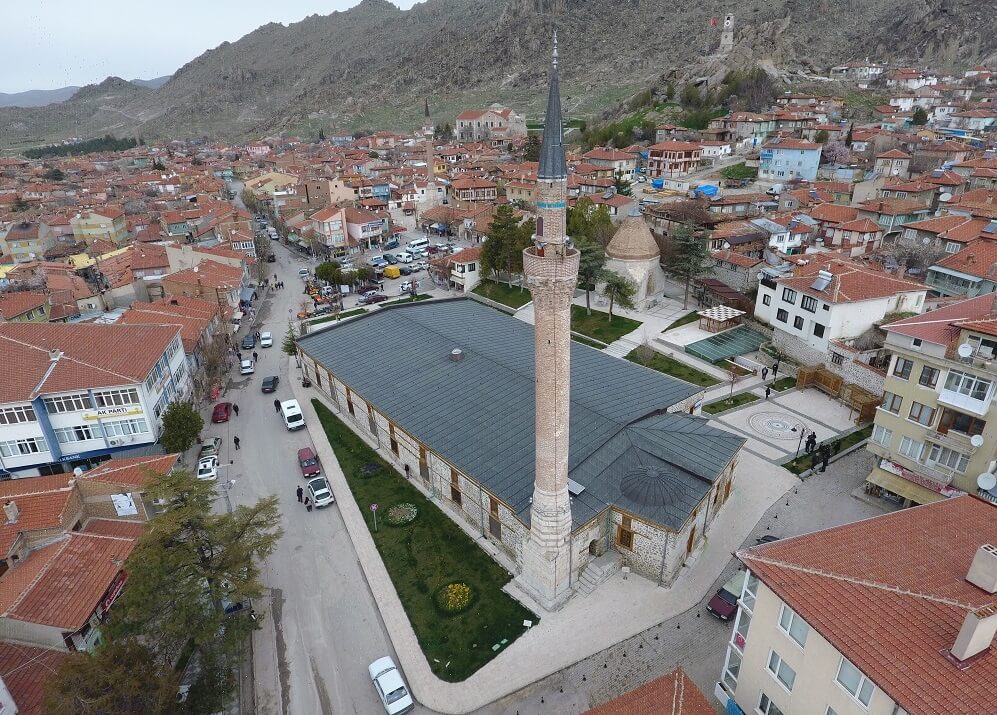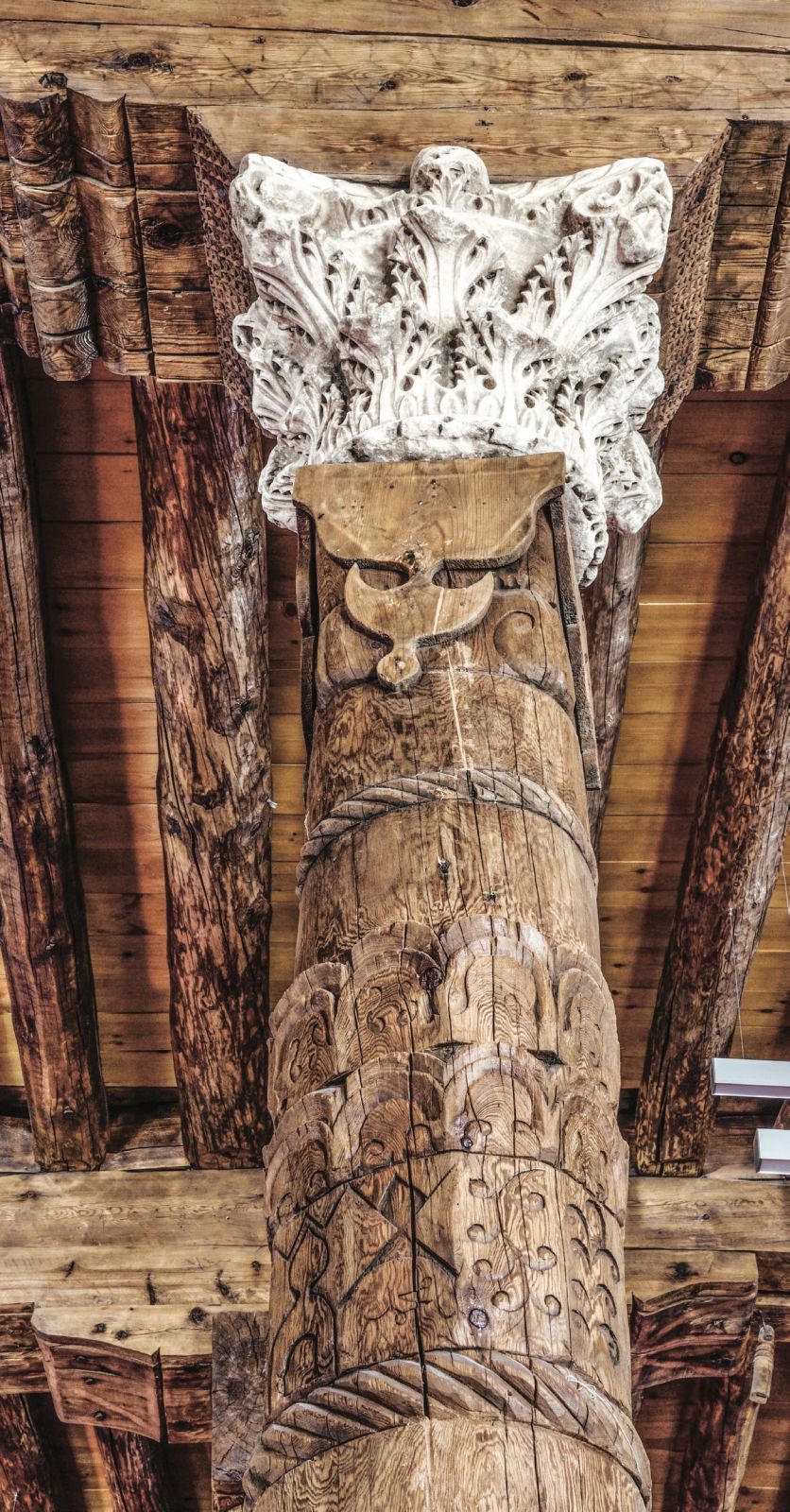Sivrihisar Grand Mosque, located in the Sivrihisar district of Eskişehir, is one of Anatolia's oldest and largest wooden-columned mosques, holding great architectural and historical significance. Although its exact construction date is unknown, inscriptions suggest that the mosque was initially built in 1232 during the reign of Anatolian Seljuk Sultan Alaeddin Keykubad I by Emir Cemaleddin Ali Bey. It acquired its current appearance following a major restoration in 1274, commissioned by Eminüddin Mikail Bey, the son of Abdullah and one of the regents of Sultan Giyaseddin Keyhusrev III. Over time, the mosque has been shaped by various restorations, each adding a unique aesthetic touch to the structure.

Sivrihisar, Grand Mousque. (Source: Sivrihsar Belediyesi)
Architectural Features and Structural Details
The minaret, added to the mosque's southern facade in 1410, harmonizes aesthetically with the overall structure. Additionally, the details incorporated into the mihrab during the 1440 restoration are among the significant elements reflecting the mosque's rich history. The minbar, dated to 1245, was brought to the mosque from the Sivrihisar Kılıç Masjid, which was demolished in 1924. It is one of the finest examples of the elegant wooden craftsmanship of the Seljuk era.
Facades and Entrances
The mosque’s interior is designed in a rectangular plan parallel to the mihrab, with entrances on its northern, eastern, and western facades. The marble portal on the northern facade features an inscription documenting the mosque’s restoration history. On the eastern facade, a simple marble-framed door bears two distinct inscriptions detailing the mosque’s first restoration by Eminüddin Mikail Bey, whose stylized emblem is also depicted. Furthermore, the protruding section known as the "Sölpük Masjid" on the eastern facade features a 1232 inscription, serving as a historical document of the mosque’s original construction. The marble door on the western facade has a simple design, placed in a way that maintains the balance of the mosque’s exterior.
Interior and Wooden Columns
Sivrihisar Grand Mosque is renowned for its wooden columns, which are a defining feature of its interior. These columns divide the space into six naves parallel to the mihrab. With a total of 67 wooden columns, the mosque is the largest of its kind in Anatolia, showcasing its impressive scale and architectural significance.

Sivrihisar Grand Mosque Wooden Columns (Source: Sivrihisar Belediyesi)
The columns are made of juniper and yellow pine wood, with some topped by ancient capitals. It is believed that several of these capitals, used as bases for the columns, were brought from the ancient city of Pessinus, located 16 kilometers from Sivrihisar on the Ankara-Eskişehir road.

Sivrihisar Grand Mosque Wooden Columns (Source: Sivrihisar Belediyesi)
Although the interior of the mosque is designed with a simple architectural approach, the decorations on the columns enrich this simplicity. All the columns are adorned with elegant ornaments in the style of Central Asian tent architecture. The prayer hall has a rectangular plan oriented east-west, with the naves separated by beams connected to wooden columns. Circular panels placed between these beams are completed with wooden coverings on top. The columns opposite the minbar and mihrab are decorated with rich carvings and reliefs. Some columns near the mihrab feature brass diamond-shaped plates painted with green and black patterns, preserving their original features. While the columns near the market exit are simpler, some have maintained their original structures over time.
The interior of the mosque is divided into six naves parallel to the mihrab wall by wooden columns. These columns, connected to beams with wooden brackets, provide an aesthetic balance to the wide interior space while enriching the atmosphere of the prayer hall. A small central lantern is an essential element for lighting the interior of the mosque, reflecting the simple and functional architectural style of the Seljuk period. The ceiling of the interior is covered with wooden planks.
The mosque’s roof includes a small lantern designed for ventilation, which also aids in the mosque’s air circulation. The floor is constructed using a technique known as yarma and is covered with wooden panels. During restoration, interlocking floorboards were used to enhance the floor's durability. The columns rest on stone foundations, and a gap of up to 150 cm has been left between the ground and the floor to protect the mosque from moisture. This structural feature contributes to the mosque's durability and longevity.
The columns of the Sivrihisar Grand Mosque are unique works of art that contribute not only to the functional aspects of the structure but also to its visual richness. Both the woodwork and decorative elements reflect the Seljuk era’s artistry and leave an important legacy. These columns play a significant role in maintaining the mosque's aesthetic balance and preserving its historical heritage.
The Minbar
The minbar of the Sivrihisar Grand Mosque is one of the most remarkable examples of Anatolian Seljuk art, standing out as a masterpiece of wooden craftsmanship. The minbar was crafted by Horasanlı Ibn-i Mehmet using the kündekari technique, where no nails were used, a feature that enhances both its durability and aesthetic value. Made of walnut wood, the minbar features delicately carved Rumi and palmette motifs within protruding geometric sections, along with elegant latticework and fretwork, making it one of the finest examples of Seljuk woodwork.

Sivrihisar, Grand Mosque Minbar (Source: Sivrihisar Belediyesi)
The minbar, brought to the mosque from Kılıç Masjid, which was demolished in 1924, is one of the most valuable artifacts within the mosque. The door of the minbar features Ayat al-Kursi, crowned with a strip that forms a pointed arch when the door panels are closed, giving it an elegant appearance. The inscription on the minbar indicates, through the abjad numerical system, that it was crafted in 1245, further emphasizing its historical significance. As one of the finest examples of Seljuk-era art and woodcraft, the minbar adds a unique value to the mosque.
Roof and Restoration
The mosque, covered externally with a hipped roof tiled with terracotta, was recently reinforced with a lead covering using modern restoration techniques to ensure its longevity. This measure protects the mosque's exterior and shields it from the adverse effects of time and environmental conditions.
UNESCO World Heritage List
Sivrihisar Grand Mosque is the first structure from Eskişehir to be inscribed on the UNESCO World Heritage List. On September 25, 2023, during the 45th UNESCO World Heritage Committee meeting held in Riyadh, Saudi Arabia, the mosque was added to the prestigious list. As the first entry from Eskişehir and the 21st cultural heritage site from Turkey, the mosque holds a special place in history. With a capacity to accommodate 2,500 worshippers simultaneously, it is also one of the largest hypostyle mosques. Its architectural brilliance, along with its historical and cultural significance, makes it an invaluable treasure. The inclusion of Sivrihisar Grand Mosque on the UNESCO World Heritage List has contributed to the international recognition of both Eskişehir and Turkey's cultural heritage.


